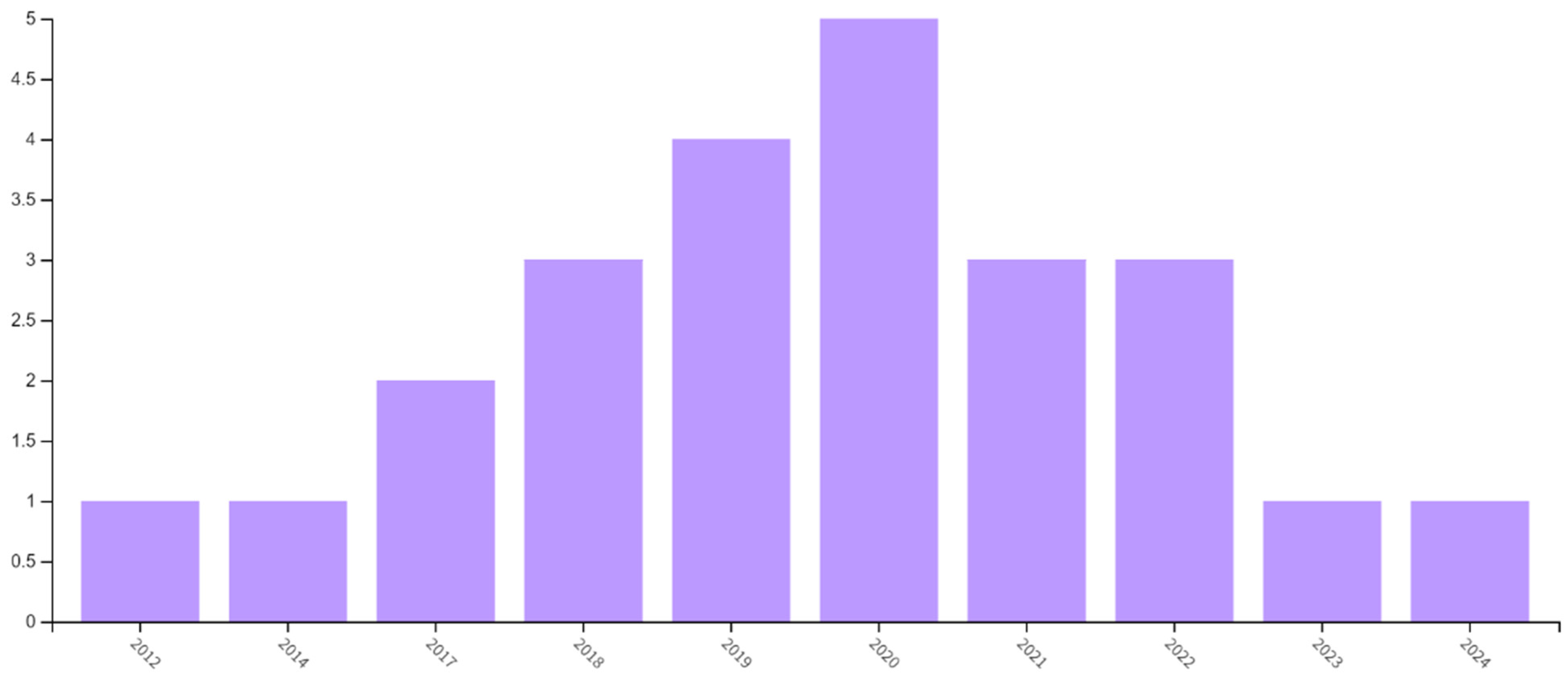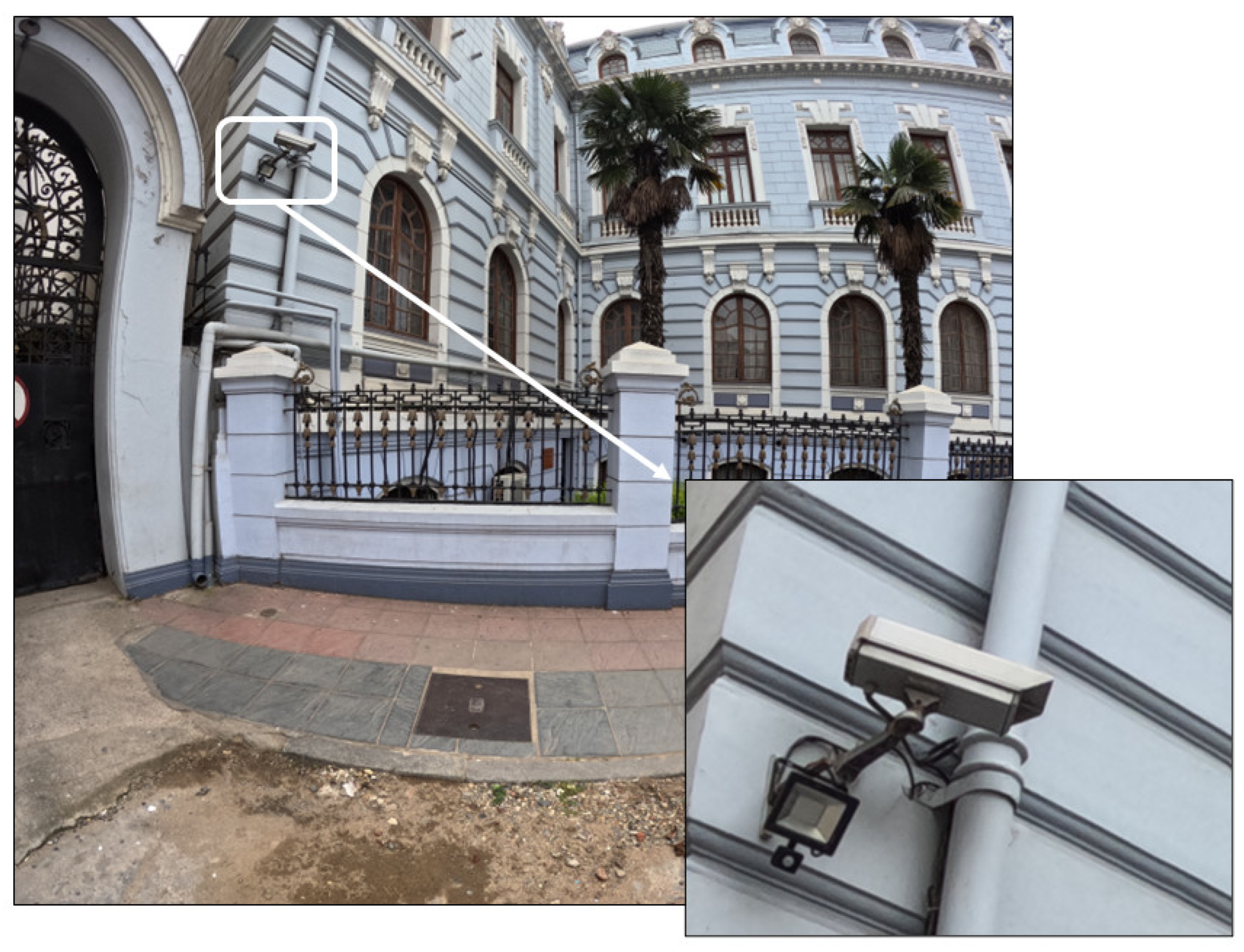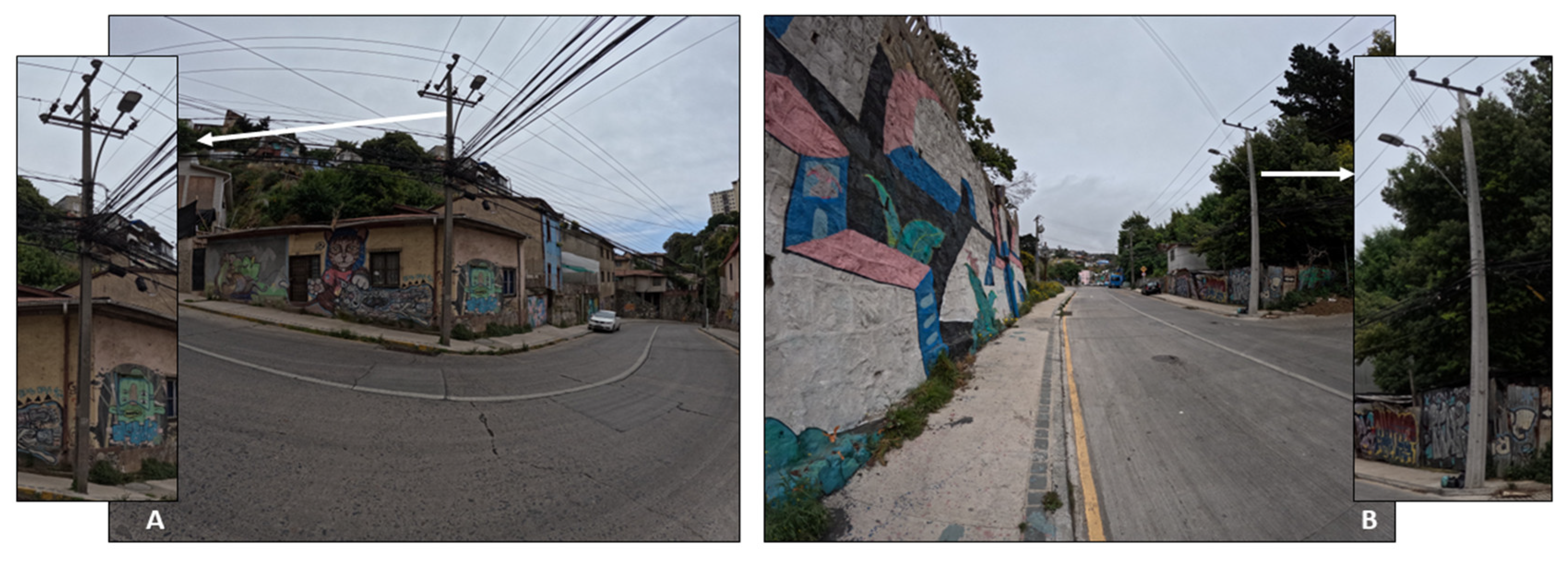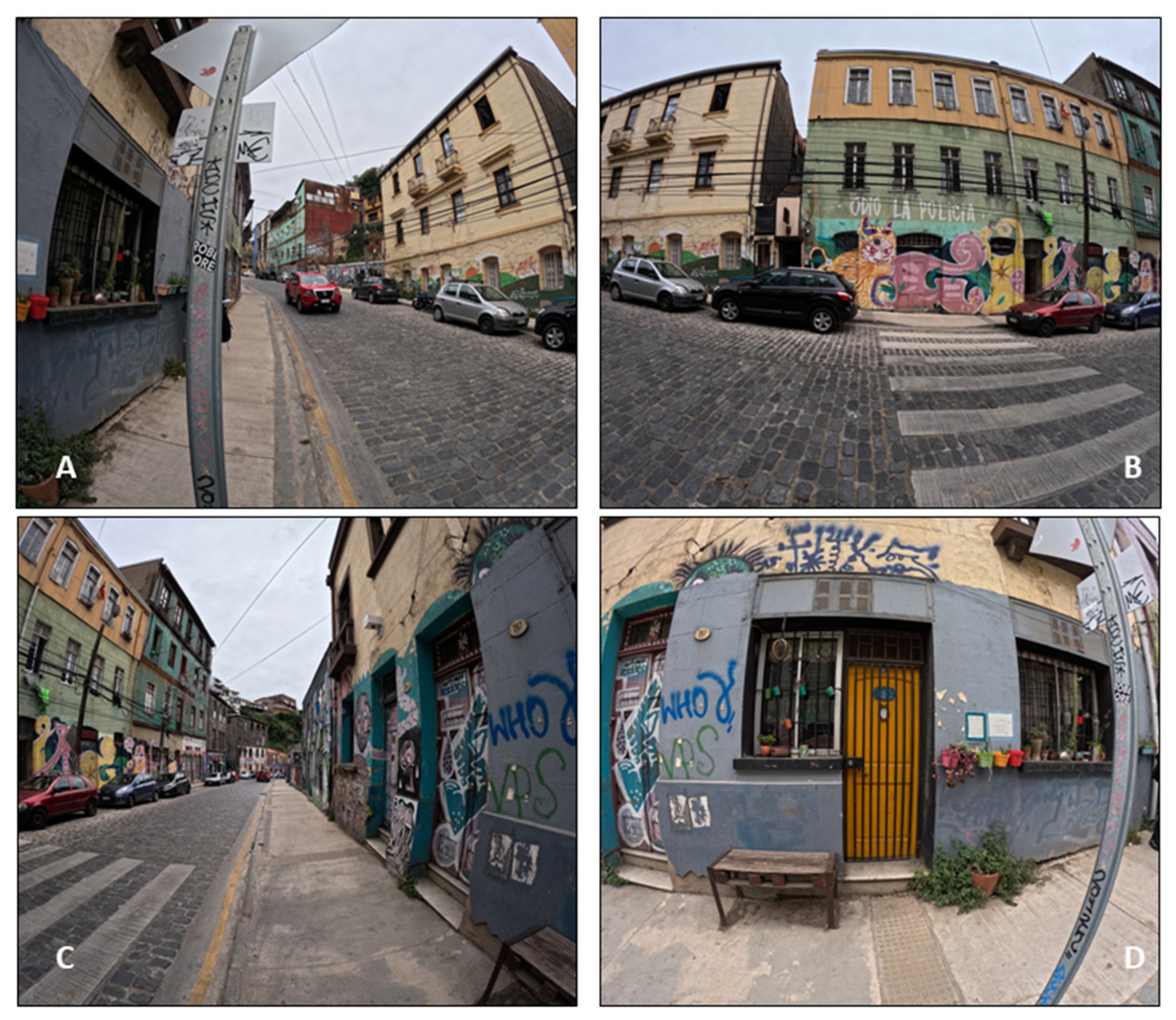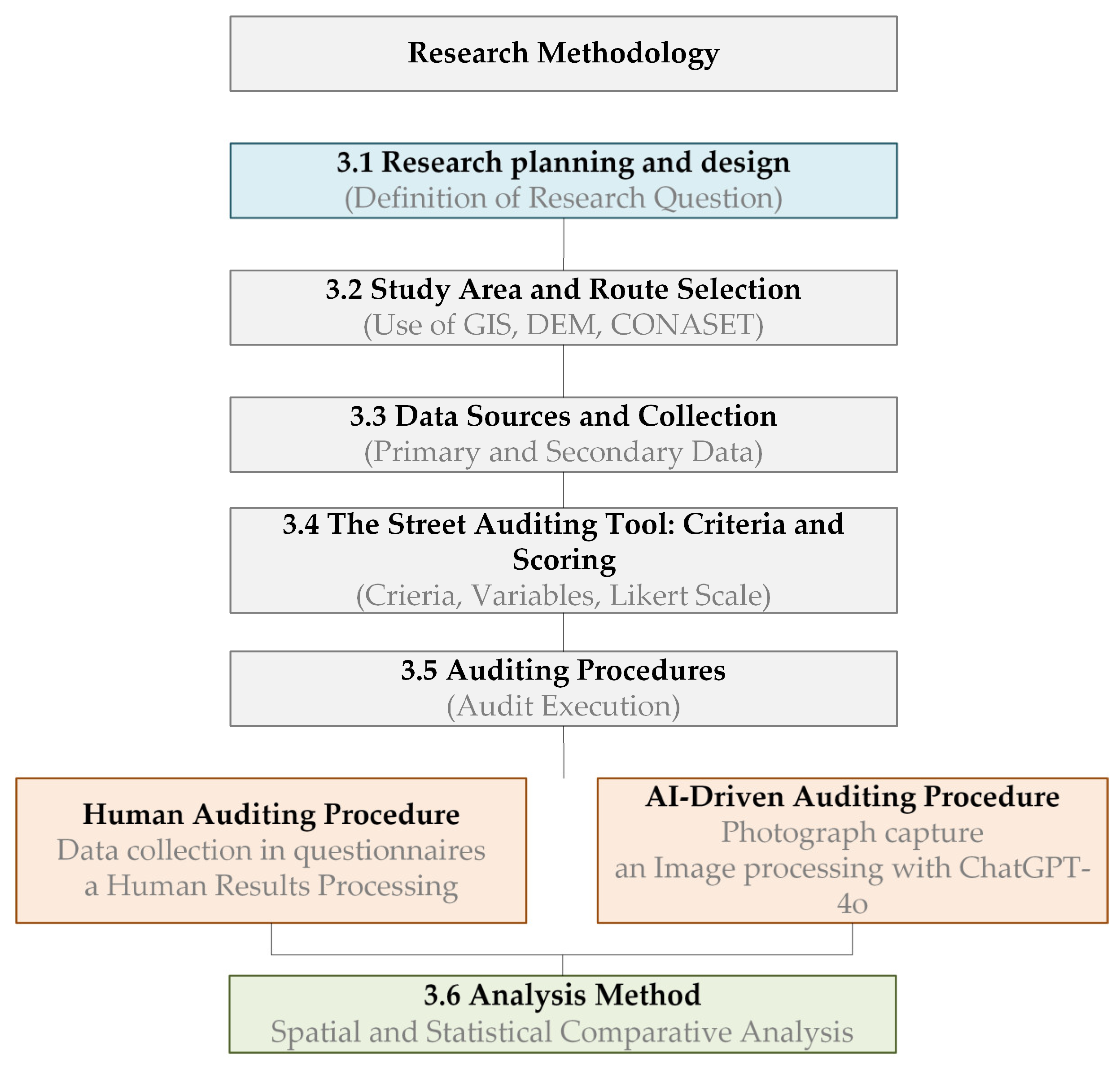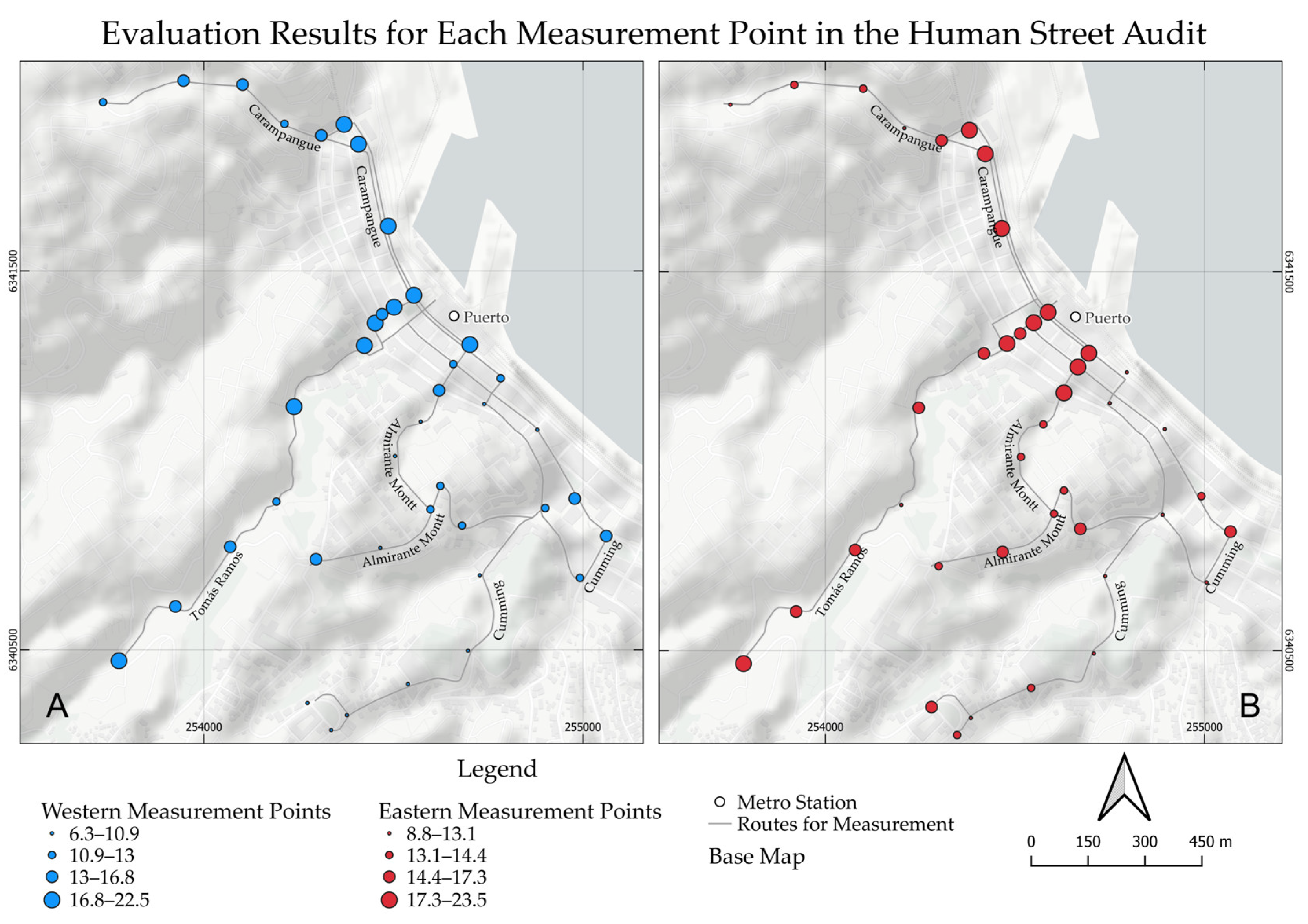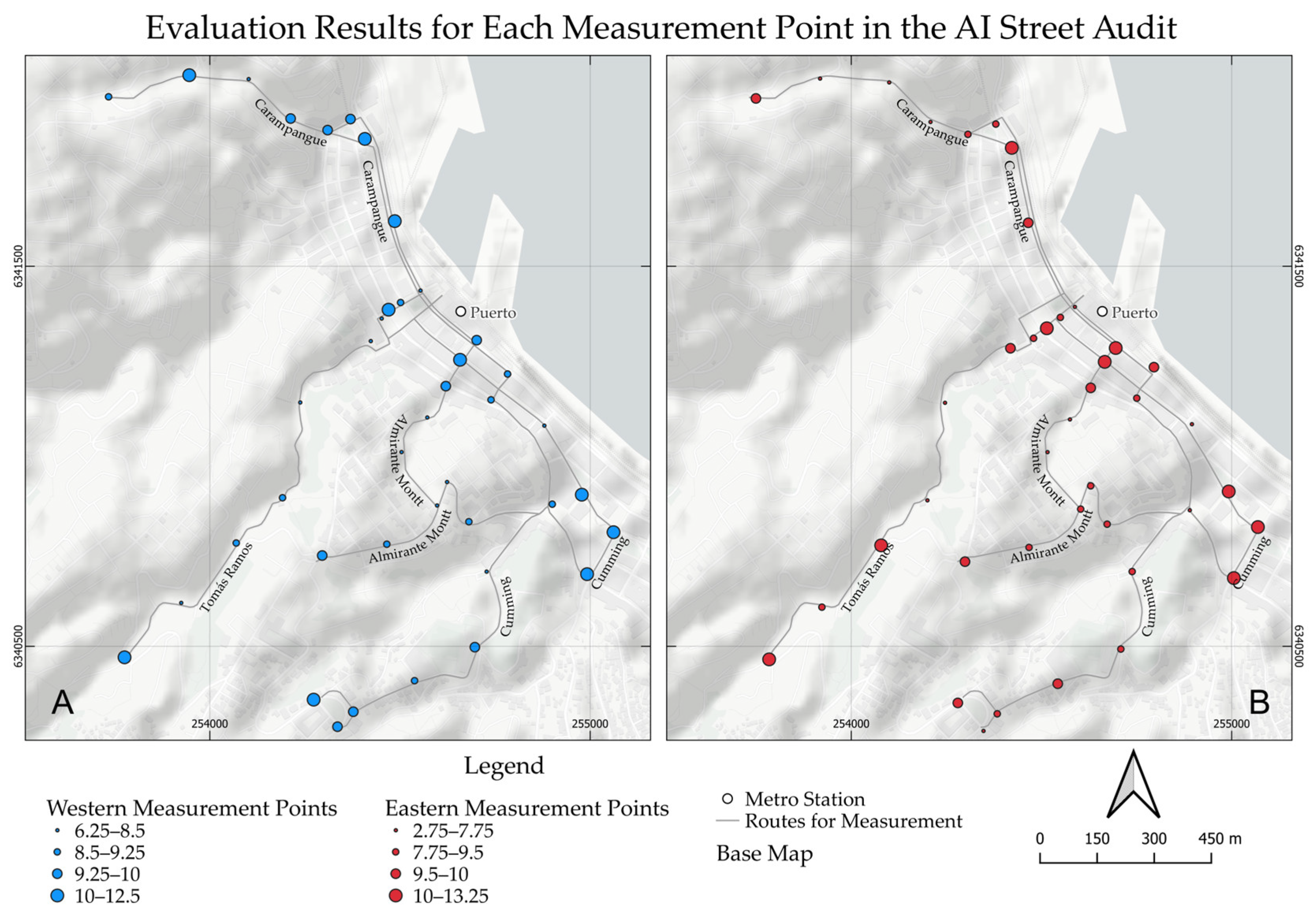1. Introduction
A promising approach to overcoming the limitations of traditional, resource-intensive street auditing is the use of artificial intelligence (AI) and publicly available street view imagery (SVI). Recent advancements demonstrate that AI can automate the creation of detailed mobility evaluations in complex urban environments. For instance, AI-driven methods can now automatically key infrastructure features such as sidewalk characteristics for wheelchair users [
1]. Furthermore, specialized models show high accuracy in detecting critical accessibility components like curb ramps, helping to address gaps in officially available data [
2]. This technological shift is not limited to feature extraction; multimodal AI systems like StreetViewAI can interpret complex streetscapes to provide rich, context-aware descriptions that aid navigation for people with visual impairments, showcasing AI’s growing capacity for nuanced environmental understanding [
1,
2,
3,
4,
5].
However, despite the clear potential of AI in automating urban audits, its widespread adoption by planners and municipalities is hindered by concerns regarding the quality, reliability, and validity of the generated data. A critical research gap remains in understanding how AI-driven assessments compare to traditional human-led audits, particularly in capturing the subjective and contextual elements of urban experience. As Askari et al. [
3] argue, validating data from emerging sources against established methods is essential for building “data trust” and ensuring their legitimacy for official planning purposes.
Therefore, this study seeks to answer the following question: How do the assessments of potential e-bike routes in Valparaíso differ when conducted through a human-led, in situ street audit versus an automated, AI-driven audit using street imagery? To answer this question, it is important first to understand the context of the case study, which is the city of Valparaíso. Furthermore, it is relevant to put into context how this study is related to the sustainable mobility concerns.
Previous mobility studies applied to the city of Valparaíso, Chile, have evidenced the complex socioeconomic, urban, and topographic of the city [
6,
7,
8]. Fernandes and Tirado [
6], for example, identified that vulnerable populations that live in the hills of Valparaíso, regarding mode of transport, are sustainable because they tend to walk or use public transport. However, they are exposed to poor urban and transport infrastructure, which reflects the socioeconomic gap in the city. In addition, Aprigliano, Toro et al. [
8] highlighted that internal trips by car in the city of Valparaíso have an average distance of approximately 800 m. Also, the authors note that most car users live near the city’s central business district. Considering the city’s complex geography, it is relevant to explore local scale analysis of the streets of the city in order to potentially promote electric bicycles to reduce the inequality in accessibility evidenced by Aprigliano, Toro et al. [
8], contributing to the sustainable mobility.
It is interesting to note the alternative approach regarding sustainable mobility proposed by Banister [
9]. This author highlights the relevance of focusing on the social dimension, accessibility, people instead of vehicles, street as a space, local scale, etc. However, exploring sustainable mobility from a local and geographical perspective, as well as from an academic perspective, is still timid, considering that this concern has been highlighted since the beginning of the end of the 20th century, for example, through the 1992 conference of the United Nations in Rio de Janeiro [
10]. A search was conducted in the Web of Science database on 11 November 2024, using the keywords “sustainable mobility” and “local scale” in all fields, filtering Web of Science categories to transportation and geography, the system delivers five documents [
11,
12,
13,
14,
15].
Regarding the relationship between sustainable mobility and the local scale approach, Lucas [
11] highlights that the local scale approach allows the promotion of specific policies to confront the public transport deficit and ease the mobility and accessibility of vulnerable populations. With a focus on shared mobility issues, Coll et al. [
12] affirm that local factors, such as density and access to services, favor promoting shared and sustainable mobility. Examining parking issues, Wang and Liu [
13] indicate that local policy perspectives are required to promote sustainable mobility, with a specific focus on equity between urban centers and suburbs. With an environmental focus, Singh et al. [
14] suggest the need to align local solutions to global concerns to better tackle the impact of the environment, such as noise pollution, to promote sustainable mobility. Interestingly, focusing on implementing cycleways, Ploegmakers and Lagendijk [
15] identified that external financing and local collaboration are key to promoting sustainable infrastructure at a regional scale.
From studies that relate the use of bicycles and local scale perspective, it is possible to evidence five themes of concern: infrastructure and urban design [
16,
17,
18]; safety and risk assessment [
19]; access and spatial equity [
20]; community collaboration and local governance [
15,
16]; built environment and social context [
16,
18]. In terms of E-bike research and its potential promotion in urban areas, it is relevant to mention Aprigliano et al. [
21], which evaluated, with secondary data, potential routes for E-bikes in Valparaíso, in addition to developing experimental studies that evidence the potential of E-bike users to overcome steep slopes of the city.
Regarding the objective, within the context of promoting E-Bike use in the city of Valparaíso and exploring local scale assessment, this study seeks to compare the results of human and AI-driven street auditing methods directed at identifying adequate routes for E-Bikes in the city that connect the metro station Puerto to Alemania Avenue, a key street that connects different hills of Valparaíso. In addition, through AI-driven auditing methods, this research expands the audited streets to other potential routes connecting other metro stations of the city to Alemania Avenue. In terms of the research gap, by comparing human and AI-driven auditing, there may be the possibility of reducing subjectivity delivered by human evaluation, as mentioned by Grabow et al. [
22], and also the possibility of validating AI-driven audits, which was one of the pointed-out limitations of Ito and Biljecki [
23].
It is important to point out that other studies related to E-Bike use and spatial analysis have identified different challenges regarding the promotion of this mode of transportation, such as infrastructure that allow safe use of E-Bikes [
24], psychological and social limitations regarding safety perceptions and environmental awareness [
25], initial cost and lack of incentives to promote a shift towards E-Bikes [
26], and battery maintenance and recycling [
24]. Regarding the slope criterion, the previously mentioned papers affirm that E-Bikes allow reductions in physical effort [
25], may induce cyclists to prefer routes with slopes compared to conventional cyclists [
26] and increases the possibility of people seeing the E-Bike as a viable mode compared to cars or public transport, especially in a city with a hilly landscape [
24,
26]. For these reasons, it is valid to make effort in evaluating potential routes for E-Bikes in the city of Valparaíso, where approximately 94% of the population resides in the hills of the city [
27] and 57.29% of the city has an average slope higher than 6%, calculated from a digital elevation model obtained from the Spatial Data Infrastructure of Chile [
28].
Concerning the structure of the paper, besides this introduction, it consists of five other sections.
Section 2 (literature review) explores different approaches to street auditing for bicycles.
Section 3 (materials and methods) focuses on describing the research planning and design, the audit tool applied, the human street audit procedure, AI-driven auditing methods, and the analysis methods.
Section 4 (results) presents the results of each audit method and the expanded results of the AI-driven auditing in the city of Valparaíso.
Section 5 (discussion) develops a discussion about the results, and the
Section 6 (conclusions and final considerations) discuss the applications, practical and policy implications, limitations of the study and further opportunities to explore the research developed here.
2. Literature Review
Seeking in the Web of Science Database, 07 November 2024, with the keywords “street audit” and “Bicycle”, the output was 27 papers, and 7 of them were closely related to the application of street audit methods related to bicycle use in cities, which are further explored in this
Section 2, focusing on audit methods, variables and results obtained. Interestingly, it is possible to observe that publications related to street audits and bicycles reached a peak between 2019 and 2020, possibly related to the growing concerns about COVID-19 and the agglomeration in urban spaces (see
Figure 1).
Aiming to identify built environmental factors associated with cycling in different regions of Europe, Mertens et al. [
29] apply a virtual neighborhood audit through the Google Street View tool, gathering information on speed limits, the existence of bicycle lanes, traffic calming features, presence of trees, litter, and parked cars. Results of this study pointed out, for example, that places with speed limits under 30 km/h and more cycle lanes present lead to higher cycling levels. Similarly, Auchincloss et al. [
30] focus on assessing physical activity changes after implementing greenways in low-income neighborhoods and use methods related to systematic observation and environmental audits. Regarding the variables for the audit process, the authors focus on the design, amenities, and esthetics dimensions of the Path Environment Audit Tool (PEAT) [
31]. Unlike Mertens et al. [
29], Auchincloss et al. [
30] did not find a significant relationship between greenways and increased physical activity, such as cycling.
Figure 1.
Publications by year delivered by Web of Science Database. Search keywords are street audit (All Fields) AND bicycle (All Fields) [
32,
33].
Figure 1.
Publications by year delivered by Web of Science Database. Search keywords are street audit (All Fields) AND bicycle (All Fields) [
32,
33].
On the other hand, instead of developing in loco auditing, Antonakos et al. [
34] examine GigaPan imagery for environmental audits. The audit variables included elements such as pedestrian amenities, recreation facilities, presence of services and commerce, physical activity venues, presence of crosswalks, etc. Results of this study demonstrate that a lower body mass index of people is associated with pedestrian-friendly features. In the same direction, Desjardins et al. [
35] compare objective route attributes measured through a street audit of Google Street View images and the perception of cyclists collected through a semi-structured interview of cyclists. Variables of the street audit were divided into two dimensions. The first is predominant buildings/features, including transport infrastructure, housing, office, retail, etc. The second is bicycle infrastructure, including specific characteristics of the cycle lanes, slope, road conditions, traffic calming devices, etc. This study mainly indicates that cyclists preferred routes with dedicated bike lanes and lower traffic levels.
Still, with the support of digital images for auditing, Cleland et al. [
36] developed a micro-level audit tool to evaluate urban and mobility factors influencing neighborhoods through Google Street View. For the audit, the authors consider several variables related to livability, safety, sustainability, health, and bicycle infrastructure indicators. The presented results indicate that livability relates to factors like pedestrian activity, overall car presence, the number of parked cars, and bicycle rack counts. In addition to digital imagery audits and different from previously reviewed papers, Ito and Biljecki [
23] also implemented automated auditing of street view imagery to measure the bikeability of places. Variables in this automated audit process involve amenities, the built environment, and transport infrastructure. Results delivered interesting auditing results. However, the authors affirm that there is a need for further stages for validating results. On the other hand, Maddock et al. [
37] with the objective of assessing pedestrian and bicycling environmental friendliness apply in loco street auditing measuring aspects related, for example, to sidewalks, crossing aid and pedestrian/bicyclist traffic.
Table 1 presents information on the criteria, variables, and references of studies that used each variable. It is interesting to identify that safety, infrastructure conditions and accessibility presented more relevance to most of the studies, while it is relevant to highlight the concerns with esthetics and comfort. Regarding comfort with the emergence of E-Bikes in recent years, the consideration of this variable in future studies may increase for the next years.
Table 1.
Criteria and Variables Considered in Street Audit Procedures Focused on Bicycle. Source: Elaborated by authors.
Table 1.
Criteria and Variables Considered in Street Audit Procedures Focused on Bicycle. Source: Elaborated by authors.
| Criteria | Variable | References |
|---|
| Safety | Presence of bicycle lanes | [29,34,37] |
| Traffic-calming devices | [23,29] |
| Bicycle lane separation | [29,35] |
| Signalized crosswalks | [37] |
| Infrastructure Condition | Condition of bicycle lanes | [23,31] |
| Surface quality | [31,35] |
| Maintenance of road and lanes | [34,37] |
| Street lighting | [35,36] |
| Accessibility | Connectivity to bike paths | [30,31] |
| Availability of bike parking | [36,37] |
| Ease of access to destinations | [31,35,36] |
| Esthetic Environment | Presence of greenery | [23,29] |
| Street cleanliness | [23,36] |
| Comfort | Shade along paths | [31,36] |
| Slope/grade | [23,31] |
Beyond imagery-based virtual audits, other technology-driven approaches leverage real-time sensor data to evaluate cyclist behavior and infrastructure interaction. For example, Puyol et al. [
38] proposed a Bicycle Sharing System (BSS) using an Internet of Things (IoT) network where bicycles are equipped with sensors to transmit real-time position and speed data. Their system’s novel contribution is its ability to monitor user behavior, such as slowing for intersections, and automatically reward compliance with traffic rules through discounts on rental costs. While this represents an innovative approach for real-time BSS management and user incentivization, its methodology and objectives are distinct from the present study. In contrast, this current research focuses not on live-tracking individual cyclists but on a pre-emptive, scalable assessment of fixed street infrastructure using AI to analyze pre-existing, static street imagery for urban planning purposes.
5. Discussion
This study provides a direct comparative analysis of human-led and AI-driven street auditing methodologies for evaluating e-bike infrastructure in the complex urban environment of Valparaíso. The findings reveal a fundamental divergence between the two approaches: the human audit excels at capturing the subjective, experiential qualities of a route, while the AI audit provides a more critical and objective assessment of physical infrastructure. This divergence is not a limitation but rather a key insight into the distinct roles each methodology can play in urban planning.
The AI-driven audit demonstrated its strength in systematic and objective detection, penalizing deficiencies like steep slopes and poor pavement with a consistency that is difficult to achieve with human auditors. While the AI penalized variables associated with habitability, particularly in areas with reduced tree cover, it effectively identified consistent patterns of street infrastructure, a finding aligned with previous studies on the importance of pavement conditions and street signaling for promoting non-motorized mobility [
23,
29]. This capability makes it a powerful tool for creating reliable, large-scale inventories of physical assets, a process shown to be scalable in other urban contexts [
1,
2].
Conversely, the human audit proved indispensable for evaluating habitability and perceived safety. The results from the human audit indicate that areas with better habitability, signage, and urban dynamism coincide with the more developed, flatter zones of the routes. Human auditors integrated nuanced contextual factors essential for creating inviting mobility corridors, which aligns with broader research showing that while AI can describe a scene, human perception is still required to assess its quality and subjective impact [
3,
4]. In contrast, both methods highlighted significant deficiencies in street infrastructure, such as the lack of bicycle racks and the low quality of sewer systems.
As argued by Lucas [
11], a local-scale approach is effective for identifying spatial inequalities in infrastructure and accessibility. This study confirms that while e-bikes can overcome the steep slopes of Valparaíso [
21,
24,
26], the primary limitation for their adoption remains the existing mobility infrastructure. This reinforces the need for targeted policies to implement dedicated lanes and secure parking to promote sustainable mobility in topographically challenging cities.
Ultimately, this study is a first approach to comparing these distinct methods and argues that the future of effective urban auditing lies not in choosing one over the other, but in developing a hybrid model. By leveraging AI for objective, scalable infrastructure assessment and complementing it with targeted human audits for qualitative insights, planners can create a more robust evaluation framework. This addresses the validation challenges noted by Ito & Biljecki [
23] by clarifying the specific strengths and biases of AI. Future research should focus on refining this hybrid approach, potentially by training AI algorithms with human audit data to strengthen the AI’s ability to interpret complex contextual variables, thereby balancing objective analysis with subjective insight.
6. Conclusions and Final Considerations
A primary outcome of this research is the clear, data-driven evidence that most of the evaluated routes in Valparaíso currently lack the necessary conditions to safely promote e-bike use, particularly concerning habitability and security. This finding indicates an urgent need for public policies aimed at improving cycling infrastructure. The comparative results provide a powerful tool for policymakers; for instance, the consensus between both audit methods in identifying routes like Almirante Montt and Cumming as severely deficient provides a strong, evidence-based mandate for the targeted investment of public resources. To foster equitable mobility, policies must extend beyond the well-developed central business district to address longstanding infrastructure deficits in the vulnerable hillside communities where most of the population resides and accessibility challenges are most acute.
While these findings offer a clear path for policy, their application must be tempered by an acknowledgment of the study’s methodological limitations. The AI-driven audit, while objective and consistent, is fundamentally constrained by its data source. It analyzes static, pre-selected images and therefore cannot assess dynamic, real-time conditions such as traffic volume, pedestrian density, or temporary obstructions, all of which heavily influence a cyclist’s perception of safety. Furthermore, technical aspects like image resolution and the specific angles captured by the human operator can introduce biases. Conversely, while the in situ human audit captures this rich, multi-sensory “real experience,” it is inherently subjective, prone to inter-auditor variability, and is not a scalable solution for city-wide analysis due to significant time and cost constraints.
These complementary limitations lead directly to the most critical avenue for future research: advancing the proposed hybrid auditing model. The most promising next step is to use the detailed, perception-based data from human audits as a training set to teach AI algorithms to better recognize and score the nuanced variables that human auditors deem important, such as perceived safety and urban dynamism. The goal would be to create an AI that can serve as a scalable proxy for human perception, moving it beyond simple detection. Future work could also explore applying this comparative methodology to other micro-mobility modes or expanding the analysis to different urban typologies. Furthermore, integrating additional data layers, such as real-time traffic data or crowdsourced citizen reports, could help overcome the limitations of static imagery, leading to a more dynamic and comprehensive tool for automated urban mobility assessment.
